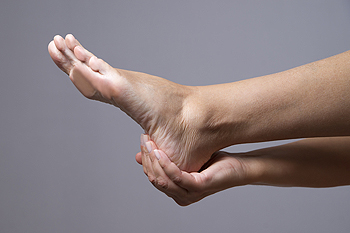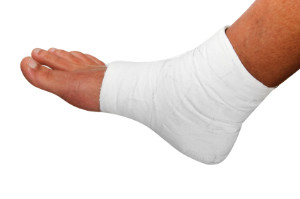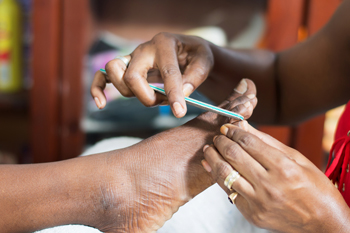Plantar warts are warts that are only found on the feet, hence the term “plantar”, which means “relating to the foot.” They are caused by the human papillomavirus, or HPV, and occur when this virus gets into open wounds on the feet. The warts themselves are hard bumps on the foot. They are easily recognizable, mostly found on the heels or ball of the foot. Plantar warts are non-malignant, but they can cause some pain, discomfort, and are often unsightly. Removing them is a common step toward treating them.
Plantar warts can cause some pain while standing, sometimes felt as tenderness on the sole of your foot. Unless the wart has grown into the foot behind a callus, you will be able to see the fleshy wart. A podiatrist should only be consulted if there is an excessive amount of pain. Plantar warts are not cancerous or dangerous, but they can affect your walking and continually reappear. Anyone who suffers from diabetes or a compromised immune system disease should seek out care immediately.
Podiatrists are easily able to diagnose plantar warts. They usually scrape off a tiny bit of the rough skin to make tiny blood clots visible and examine the inside of warts. However, a biopsy can be done if the doctor is not able to diagnose them from simply looking at them. Although plantar warts usually do not require an excessive amount of treatment, there are ways to go about removing them. A common method is to freeze them off using liquid nitrogen, removing them using an electrical tool, or burning them off via laser treatment. For a less invasive treatment option, topical creams can be used through a doctor’s prescription. This treatment method takes more time, however. Keep the wart covered for protection in between daily treatments.
The best way to avoid developing plantar warts is to avoid walking barefoot in public places. Avoid this especially if you have open sores or cuts on your feet. It is also important to avoid direct contact with warts in general, as they are highly contagious.
 If you notice a small thickened area in the heel or bottom of your foot producing severe pain and discomfort, you may have what is referred to as a verruca wart, which is more commonly known as a plantar wart. It is caused by the human papillomavirus (HPV), and will typically attack the skin on the bottom of the feet. It typically lives and thrives in moist and warm environments which may include public pools and surrounding areas, shower room floors and locker rooms. It is known to enter the body through tiny cracks in the skin and grows into the heel as a result of pressure the foot endures while walking. Many people may notice a small and callused area where the wart has formed, and small black dots may be present in the center. If you have developed a plantar wart, please speak to a podiatrist who can properly treat this condition.
If you notice a small thickened area in the heel or bottom of your foot producing severe pain and discomfort, you may have what is referred to as a verruca wart, which is more commonly known as a plantar wart. It is caused by the human papillomavirus (HPV), and will typically attack the skin on the bottom of the feet. It typically lives and thrives in moist and warm environments which may include public pools and surrounding areas, shower room floors and locker rooms. It is known to enter the body through tiny cracks in the skin and grows into the heel as a result of pressure the foot endures while walking. Many people may notice a small and callused area where the wart has formed, and small black dots may be present in the center. If you have developed a plantar wart, please speak to a podiatrist who can properly treat this condition.
Plantar warts can be very uncomfortable. If you need your feet checked, contact one of our podiatrists from San Antonio New Step. Our doctors will assist you with all of your foot and ankle needs.
About Plantar Warts
Plantar warts are the result of HPV, or human papillomavirus, getting into open wounds on the feet. They are mostly found on the heels or balls of the feet.
While plantar warts are generally harmless, those experiencing excessive pain or those suffering from diabetes or a compromised immune system require immediate medical care. Plantar warts are easily diagnosed, usually through scraping off a bit of rough skin or by getting a biopsy.
Symptoms
Treatment
To help prevent developing plantar warts, avoid walking barefoot over abrasive surfaces that can cause cuts or wounds for HPV to get into. Avoiding direct contact with other warts, as well as not picking or rubbing existing warts, can help prevent the further spread of plantar warts. However, if you think you have developed plantar warts, speak to your podiatrist. He or she can diagnose the warts on your feet and recommend the appropriate treatment options.
If you have any questions please feel free to contact one of our offices located in San Antonio, TX. We offer the newest diagnostic and treatment technologies for all your foot and ankle needs.
Read more about All About Plantar WartsThe foot and ankle area works with 26 bones, 33 joints, and more than 100 different muscles, tendons, and ligaments. Problems with any parts of this network can result in some kind trauma within the foot and ankle area. Most foot and ankle trauma is a result of aging or intense activities such as sports. However, trauma in this area can also be the result of simple things such as wearing heels too much or even walking on an uneven pavement. There are several kinds of symptoms related to specific injuries, and there are also several different treatments that could be used as well.
Foot Injuries and Symptoms
Some common injuries in the feet include stress fractures and bunions. Stress fractures are small cracks in a bone or severely bruised parts of the bone. This type of injury is caused by intense and repetitive activity, which is found in actions involved with sports and exercise. Symptoms of this injury include pain, swelling, tenderness, and possible bruising. Another common injury with bones is also bunions, which are bony bumps typically formed on the big and little toes. This injury is typically a result from wearing high heels and unfit shoes. Some common symptoms are swelling around the big and little toe areas, as well as pain and restricted movement.
Ankle Injuries and Symptoms
The common injuries associated with ankle trauma consist of sprains, strains, and fractures. These injuries are defined by the type of tissue that has been damaged. Fractures are breaks within the bones caused by sudden impacts to the area. Sprains relate to any damage of the ligaments, commonly caused by being stretched beyond their normal range of motion. Strains are attributed to damage of the muscles and tendons from being pulled too far. Symptoms of these injuries include severe pain, limited range of motion, and swelling.
Diagnosis and Treatment
Since there are several types of injuries with a variety of symptoms, it is important to see a podiatrist about your condition. Podiatrists can run a variety of tests to diagnose an injury accurately. This includes physical examinations, X-rays, or MRIs. A podiatrist may even run a stress test, which is an X-ray taken while pressure is applied to the damaged area. Once your injury has been diagnosed, the doctor may have you wear a cast or a splint, or gradually develop your range of motion. Severe injuries may require physical therapy or even surgery if necessary. If you have any concerns from past foot and ankle trauma experiences, consult with one of our podiatrists from San Antonio New Step. Our doctors can assess your condition and provide you with quality foot and ankle treatment.
If you have any questions, please feel free to contact one of our offices located in San Antonio, TX. We offer the newest diagnostic and treatment technologies for all your foot care needs.
 There are many people who enjoy the sport or hobby of running and jogging, and may experience trauma to the foot or ankle as a result of this. A common running injury may often include Achilles tendonitis, and this will affect the Achilles tendon which is located behind the heel. It typically becomes injured if the calf muscles are not properly stretched before engaging in a running activity, and the inflammation may produce pain and discomfort. Additionally, many people injure their ankles by suddenly stepping off a curb which may cause the ankle to roll inward. This may cause the tendons, ligaments, and muscles to tear, and the pain that accompanies this may cause instability in the ankle. If you have endured any ankle or foot injury, it is advised to seek the counsel of a podiatrist who can properly treat the condition.
There are many people who enjoy the sport or hobby of running and jogging, and may experience trauma to the foot or ankle as a result of this. A common running injury may often include Achilles tendonitis, and this will affect the Achilles tendon which is located behind the heel. It typically becomes injured if the calf muscles are not properly stretched before engaging in a running activity, and the inflammation may produce pain and discomfort. Additionally, many people injure their ankles by suddenly stepping off a curb which may cause the ankle to roll inward. This may cause the tendons, ligaments, and muscles to tear, and the pain that accompanies this may cause instability in the ankle. If you have endured any ankle or foot injury, it is advised to seek the counsel of a podiatrist who can properly treat the condition.
Foot and ankle trauma is common among athletes and the elderly. If you have concerns that you may have experienced trauma to the foot and ankle, consult with one of our podiatrists from San Antonio New Step. Our doctors will assess your condition and provide you with quality foot and ankle treatment.
Foot and ankle trauma cover a range of injuries all over the foot; common injuries include:
Symptoms
Symptoms of foot and ankle injuries vary depending on the injury, but more common ones include:
Diagnosis
To properly diagnose the exact type of injury, podiatrists will conduct a number of different tests. Some of these include sensation and visual tests, X-rays, and MRIs. Medical and family histories will also be taken into account.
Treatment
Once the injury has been diagnosed, the podiatrist can than offer the best treatment options for you. In less severe cases, rest and keeping pressure off the foot may be all that’s necessary. Orthotics, such as a specially made shoes, or immobilization devices, like splints or casts, may be deemed necessary. Finally, if the injury is severe enough, surgery may be necessary.
If you have any questions, please feel free to contact one of our offices located in San Antonio, TX. We offer the newest diagnostic and treatment technologies for all your foot care needs.
Read more about Foot and Ankle TraumaCracked heels may make you want to think twice about showing off your feet in warmer weather. However, cracked heels may be harmful to more than just the appearance of your feet. If deep fissures and cracks develop in your heels, they may make walking and standing painful for you. Additionally, these openings make way for germs to enter through your skin and cause infection.
There are several different causes of cracked heels. One of the most common reasons for this ailment is dry skin. This problem may make your keeps feel rough tight and itchy. Dry skin may be caused by cold air, extremely hot water, harsh soaps, and aging. Skin disorders such as eczema and psoriasis may eventually lead to dry skin. In some cases, complications may arise from cracked heels. Some of these complications are a loss of feeling in the heel, cellulitis, or a diabetic foot ulcer.
There are ways you can try to prevent getting cracked heels. One of the best ways to do so is to avoid wearing flip flops and sandals because these shoes increase your risk of drying out your feet. You should also avoid wearing shoes with a tall skinny heel, because these shoes cause your heel to expand sideways. At night, you should slather on a thick moisturizing cream on your feet and then cover them in socks to keep your feet moisturized overnight. Drinking water to stay hydrated is also a good way to ensure that your skin doesn’t become dry.
If you suffer from a severe case of cracked feet, you should make an appointment with your podiatrist to see what treatment methods are best for you.
 The condition that is known as cracked heels may cause pain and discomfort if it is not treated promptly. It may occur more frequently during the summer months when open-back shoes are worn and may happen as a result of the inadequate support these types of shoes may offer. There are several methods to treat this unsightly foot condition, and these may include washing and thoroughly drying the feet daily, followed by utilizing a good moisturizer, which may aid in keeping the skin soft. Some patients find it helpful to wear cotton socks while sleeping, and this may be preceded by applying petroleum jelly to the affected area. Additionally, using a pumice stone or exfoliating foot cream may be successful in managing cracked heels. If you are afflicted with this ailment and would like additional information about how to prevent and treat cracked heels, it is suggested to speak with a podiatrist.
The condition that is known as cracked heels may cause pain and discomfort if it is not treated promptly. It may occur more frequently during the summer months when open-back shoes are worn and may happen as a result of the inadequate support these types of shoes may offer. There are several methods to treat this unsightly foot condition, and these may include washing and thoroughly drying the feet daily, followed by utilizing a good moisturizer, which may aid in keeping the skin soft. Some patients find it helpful to wear cotton socks while sleeping, and this may be preceded by applying petroleum jelly to the affected area. Additionally, using a pumice stone or exfoliating foot cream may be successful in managing cracked heels. If you are afflicted with this ailment and would like additional information about how to prevent and treat cracked heels, it is suggested to speak with a podiatrist.
If the skin on your feet starts to crack, you may want to see a podiatrist to find treatment. If you have any concerns, contact one of our podiatrists from San Antonio New Step. Our doctors can provide the care you need to keep you pain-free and on your feet.
Cracked Heels
It is important to moisturize your cracked heels in order to prevent pain, bleeding, and infection. The reason cracked heels form is because the skin on the foot is too dry to support the immense pressure placed on them. When the foot expands, the dry skin on the foot begins to split.
Ways to Help Heal Them
Ways to Prevent Cracked Heels
If you are unsure how to proceed in treating cracked heels, seek guidance from a podiatrist. Your doctor will help you with any questions or information you may need.
If you have any questions, please feel free to contact one of our offices located in San Antonio, TX. We offer the newest diagnostic and treatment technologies for all your foot care needs.
Read more about Solutions for Cracked HeelsMillions of people are affected by diabetes each year. Diabetes damages blood vessels in all parts of the body, especially the feet. The legs and feet may develop slow blood flow, which causes neuropathy, or nerve damage. Once a diabetic patient develops neuropathy, it is important that the feet are well taken care of. Otherwise, the lower limbs may have to be amputated. This only happens in drastic cases, but it shows how seriously diabetic foot care should be taken.
It is very important to always wash and dry the feet thoroughly, especially in between the toes, if you’re a diabetic. Secondly, examining your feet and toes for redness or sores must be done, even if you do not feel pain. You may also want to examine your feet from the bottom. Try to avoid wearing colored socks to prevent infections that may occur from the dye. Well-fitting socks are also highly recommended.
A diabetic’s physician should always monitor their blood levels to test how well blood sugars are being maintained. In addition to giving advice about everyday eating habits and foot care, a physician may prescribe medicine to help with the diabetic patient’s neuropathy. It is also advised to see a podiatrist if experiencing any feet conditions. Toenails may also need to be taken care of by a podiatrist. This prevents patients from cutting too deeply around their cuticles, which can lead to infection.
A person can take care of their feet at home by following the instructions of their physician. Using creams on one’s feet is also an effective way to heal dryness. Proceed with caution when using tools to remove calluses, as severe diabetics may not be able to feel pain on their feet. If any complications arise do not hesitate to contact a podiatrist.
On a daily basis, diabetic feet must be checked. If you are ever concerned about something, contact your health care professional. You never want to wait until a wound becomes too severe to treat. If left untreated, gangrene may develop. Gangrene is a serious infection that can lead to sepsis or amputation. It is also important for diabetics to be on the lookout for ulcers. Ulcers are sores that develop from tissue loss on the skin. They can be quite painful and require intensive treatment. Early treatment and everyday inspection are imperative to staying healthy.
 Patients who are diabetic may be aware of specific foot ailments that may develop as a result of this condition. If the sugar levels in the blood become elevated, the nerves in the feet may become damaged, which may be followed by a loss of sensation. Minor conditions, which may include blisters, corns, bunions or calluses, may become serious issues to contend with, and this may be a result of the inability to feel the pain that may be associated with these ailments. Research has indicated the importance of taking care of diabetic feet properly, and this may include trimming the toenails correctly and often, as well as washing and drying the toes thoroughly, which may prevent fungal infections from developing. If you are a diabetic patient, it is strongly suggested to schedule a consultation with a podiatrist who can properly treat foot conditions related to diabetes.
Patients who are diabetic may be aware of specific foot ailments that may develop as a result of this condition. If the sugar levels in the blood become elevated, the nerves in the feet may become damaged, which may be followed by a loss of sensation. Minor conditions, which may include blisters, corns, bunions or calluses, may become serious issues to contend with, and this may be a result of the inability to feel the pain that may be associated with these ailments. Research has indicated the importance of taking care of diabetic feet properly, and this may include trimming the toenails correctly and often, as well as washing and drying the toes thoroughly, which may prevent fungal infections from developing. If you are a diabetic patient, it is strongly suggested to schedule a consultation with a podiatrist who can properly treat foot conditions related to diabetes.
Diabetic foot care is important in preventing foot ailments such as ulcers. If you are suffering from diabetes or have any other concerns about your feet, contact one of our podiatrists from San Antonio New Step. Our doctors can provide the care you need to keep you pain-free and on your feet.
Diabetic Foot Care
Diabetes affects millions of people every year. The condition can damage blood vessels in many parts of the body, especially the feet. Because of this, taking care of your feet is essential if you have diabetes, and having a podiatrist help monitor your foot health is highly recommended.
The Importance of Caring for Your Feet
Patients with diabetes should have their doctor monitor their blood levels, as blood sugar levels play such a huge role in diabetic care. Monitoring these levels on a regular basis is highly advised.
It is always best to inform your healthcare professional of any concerns you may have regarding your feet, especially for diabetic patients. Early treatment and routine foot examinations are keys to maintaining proper health, especially because severe complications can arise if proper treatment is not applied.
If you have any questions please feel free to contact one of our offices located in San Antonio, TX. We offer the newest diagnostic and treatment technologies for all your foot and ankle needs.
Read more about How to Care for Diabetic Foot